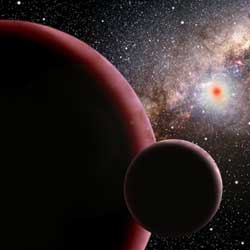
Debate erupts over whether alien planets have active plate tectonics.
Artist illustration of a super Earth. Image credit: CfA. Click to enlarge.
Nearly all the extrasolar planets discovered have been Jupiter-sized or larger. But astronomers from the Harvard-Smithsonian Center for Astrophysics think that super-earths - rocky planets several times larger that our planet - might actually be much more common. Based on the recent discovery of a super-earth around a red dwarf star 9,000 light-years away, the research team calculated that there are probably 3 times as many of these planets than the larger gas giants.

The discovery in recent years of a handful of rocky planets orbiting stars outside the Solar System has scientists wondering whether those planets are as suitable as Earth for life. This month, two research groups have entered the debate by butting heads over whether active plate tectonics are likely on such planets.
The movement of tectonic plates, which on our own planet created the Himalayas and moved the continents to their current positions, is thought to be important for moderating a planet's temperature and recycling materials that may nourish life. But do 'super-Earths' - planets with a mass up to ten times greater than our planet that are solid, unlike the gas giants - have a similar geology to our home?
Diana Valencia, leading a group of scientists at Harvard University in Cambridge, Massachusetts, says that tectonic plates are inevitible as rocky planets get bigger. As size increases, so does the amount of heat flowing up from the planet's radioactive core through the gooey mantle. This strikes the planet's crusty lid with increasing force, eventually breaking it into plates. A preprint of the paper is on Arxiv, and the paper has been accepted for publication in Astrophysical Journal Letters 1.
Valencia's logic follows from the limited trend available in the Solar System: Mars, Mercury and rocky moons lack plate tectonics. Venus, the second largest rocky planet, may have had active plates in the past. The biggest, Earth, is the only one with plate tectonics. "It might not be a coincidence," says Valencia.
Solid surface
But Earth might be an anomaly, and the trend might not extend to bigger rocky planets says Craig O'Neill, a planetary scientist at Macquarie University in Sydney, Australia.
O'Neill and his group have come to the exact opposite conclusion to Valencia. Their model, published in Geophysical Research Letters 2, shows that as a planet gets bigger, the increasing force of gravity squeezes crustal rocks together into a solid lid, making it more difficult for forces from below to crack it into plates.
A large, capped-lid planet could be like Venus, with a hellish atmosphere and runaway greenhouse effect. It could be cold and dead like Earth's Moon. Or, if fed by internal heat from the core, it could vent that heat through massive bouts of volcanism, as on Io, a moon of Jupiter. That doesn't necessarily rule out life, but it might make it difficult.
Far from home
Some scientists say both papers are premature. Science doesn't even understand plate tectonics on Earth, so it shouldn't be making predictions for other worlds, says Dave Stevenson, a planetary scientist at the California Institute of Technology in Pasadena.
"Both papers are somewhat speculative and quite a long way removed from anything that's likely to be confirmed in the future with observation," says Stevenson. The models both neglect the crucial influence of water, which softens up and lubricates tectonic plates. They also make assumptions about parameters, such as the viscosity of the mantle or the strength of the crust, for which the values are unknown to within several orders of magnitude.
Researchers on both sides of the debate welcome critique, arguing that the community needs to grapple with these questions now.
Valencia points out that scientists need to prepare for planet-hunting projects such as NASA's Kepler and Terrestrial Planet Finder missions. One of her co-authors, Dimitar Sasselov, who is director of the Harvard University Origins of Life Initiative, says that five years ago, nobody cared about modelling tectonics on super-Earths. If his paper riles up other scientists, he says, "that makes me happy".

No comments:
Post a Comment